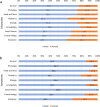Gender differences in publication rates at Canadian Society of Otolaryngology-Head and Neck Surgery annual meetings: an 11-year analysis
- PMID: 36759903
- PMCID: PMC9909880
- DOI: 10.1186/s40463-022-00612-7
Gender differences in publication rates at Canadian Society of Otolaryngology-Head and Neck Surgery annual meetings: an 11-year analysis
Abstract
Background: Evaluating gender differences in publication rates after conference presentations is an avenue to assess women's contributions to academic medicine. The objective of this study was to assess gender differences in publication rates, time to publication, and subspeciality of publication of abstracts presented at Canadian otolaryngology conferences over an 11-year period.
Methods: Cross-sectional data was obtained from online conference schedules of annual Canadian Society of Otolaryngology-Head and Neck Surgery national meetings between 2009 and 2020. A total of 2111 abstract titles were searched in MedLine via PubMed. Gender of the first and senior author, publication status of presented work, and subspeciality of publication were extracted.
Results: Of 2111 scientific abstracts presented between 2009 and 2020, female first and senior authors accounted for 29.0% and 12.8% of published abstracts, respectively. There was a significant difference in the publication rate of senior authors by gender (p < 0.01). Male senior authors had a 9.70% higher rate of publication compared to female senior authors. Posters with a female first author were 33.0% (OR: 0.67; 95% CI 0.49-0.91) less likely to be published compared to posters with a male first author. Similarly, posters with a female senior author were 34.0% (OR: 0.66; 95% CI 0.45-0.96) less likely to be published. There was a significant difference in discipline of publication by gender of the senior author (p < 0.001). Male senior authors were more likely to supervise projects in otology while female senior authors were more likely to supervise projects in education and pediatrics. The time to publication and impact factor of the journal of publication did not differ by gender.
Conclusion: Gender disparities exist in the publication rates of first and senior authors at Canadian otolaryngology meetings. Female senior authors have significantly lower publication rates compared to their male colleagues and differences exist in publication rates after poster presentations. Investigation of gender gaps in academic medicine, research productivity, and publications is essential for development of a diverse, equitable, and inclusive workforce in otolaryngology.
Keywords: Gender; Otolaryngology; Publications; Research.
© 2023. The Author(s).
Conflict of interest statement
The authors declare that they have no competing interests.
Figures




Similar articles
-
Publication rates of research presented at the Canadian Society of Otolaryngology-Head and Neck Surgery Annual Meetings from 2008 to 2018: an 11-year review.J Otolaryngol Head Neck Surg. 2023 Feb 8;52(1):9. doi: 10.1186/s40463-022-00606-5. J Otolaryngol Head Neck Surg. 2023. PMID: 36755322 Free PMC article. Review.
-
Publication rate of abstracts presented at the Canadian society of otolaryngology- head and neck surgery annual meetings: a five year study 2006-2010.J Otolaryngol Head Neck Surg. 2014 Dec 17;43(1):51. doi: 10.1186/s40463-014-0051-5. eCollection 2014. J Otolaryngol Head Neck Surg. 2014. PMID: 25515294 Free PMC article.
-
Presentation and publication rates among women and men at AAO-HNS meetings.ORL J Otorhinolaryngol Relat Spec. 2012;74(6):325-9. doi: 10.1159/000345099. Epub 2013 Jan 5. ORL J Otorhinolaryngol Relat Spec. 2012. PMID: 23295356
-
Gender diversity at spine surgery academic conferences: a 15-year investigation.Spine J. 2024 Aug;24(8):1369-1377. doi: 10.1016/j.spinee.2023.11.018. Epub 2023 Dec 9. Spine J. 2024. PMID: 38081462
-
A re-appraisal of publication rates of scientific papers presented at the Otorhinolaryngology Research Society meetings.Clin Otolaryngol. 2016 Dec;41(6):694-699. doi: 10.1111/coa.12594. Epub 2016 Feb 22. Clin Otolaryngol. 2016. PMID: 26589964 Review.
References
-
- Evans S, Sarani B. The modern medical school graduate and general surgical training: are they compatible? Arch Surg Chicago IL 1960. 2002;137(3):274–277. - PubMed
-
- Table 13: U.S. Medical School Faculty by Sex, Rank, and Department, 2019 [Internet]. AAMC. https://www.aamc.org/media/8441/download?attachment.
MeSH terms
LinkOut - more resources
Full Text Sources

